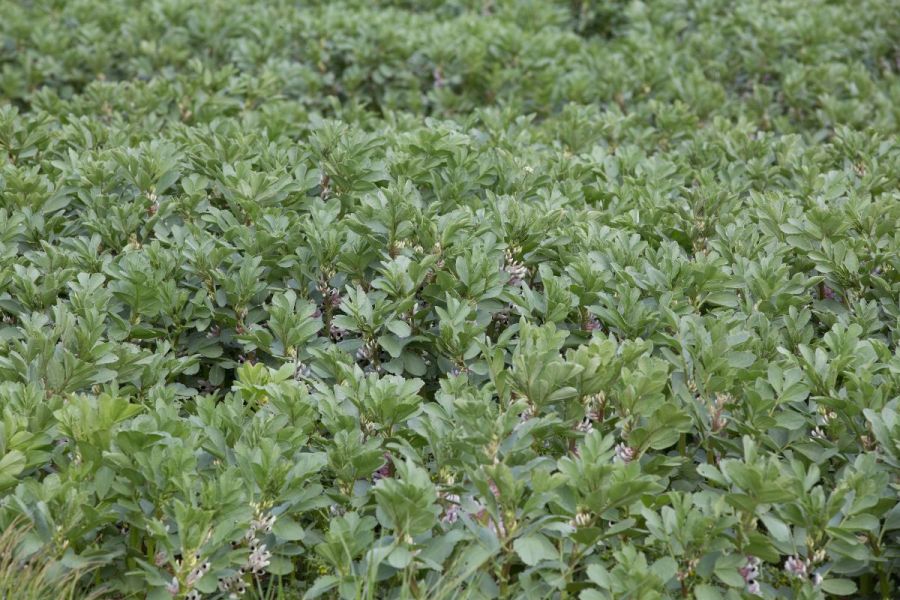Growing beans has a multitude of known benefits, be it improved soil health or retained nitrogen for the following wheat crop, but what about replacing soya in laying hen feed to produce a carbon neutral egg? CPM investigates.
“In the long-term we want to reduce soya use by 100%.”
By Melanie Jenkins
With COP27 only just wrapped (at the time of writing), the conversation surrounding cutting carbon emissions is as sharp as it’s ever been. One farm in Scotland has taken it upon itself to reduce its carbon emissions and attempt to produce a carbon neutral egg.
Arable farmers could play a crucial role in decarbonising egg production, with the farm in question cutting its use of imported soya by adding beans to its arable enterprise.
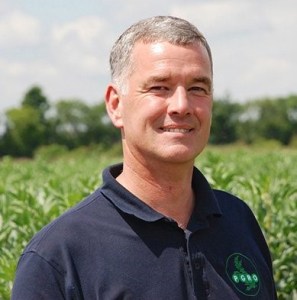
Beans have stood out as a more environmentally friendly alternative to imported soya beans, says Roger Vickers.
Rotationally, beans and peas are underutilised in the UK, states Roger Vickers of PGRO. “About 4% of the UK’s arable cropping area is used to grow pulses. When these are included in a rotation, it’s sensible to have them one in every five years, meaning 20% of the cropped area could potentially be pulses.
“The upside of legumes is that they don’t require any nitrogen fertiliser and can help to produce a higher yield – of anything up to around 1t/ha – in the subsequent wheat crop,” he says. “This comes from improved soil fertility and the N left behind by the crop, which averages around 70kgN/ha – but this does vary, it can be a lot more or a fair bit less.”
As well as residual N, the interaction of root exudates with minerals in the soil helps to release them into a more readily available form for the following crop, explains Roger. “There’s also a very strong mycorrhizal association with pulses.
“Growers often comment on how nice seedbeds are after the crop, which can mean fewer cultivations are needed, easier preparations, reduced machine use, lower diesel consumption and minimised impact and damage to soils as a result.”
And in terms of marketing, the largest outlet for beans in the UK is for human consumption, but a new market could potentially be opening up for livestock feed. As producers look to cut their carbon emissions this has driven them to assess feed inputs, with soya beans standing out as a prime candidate for substitution due to their environmental impact from deforestation in South America, says Roger.
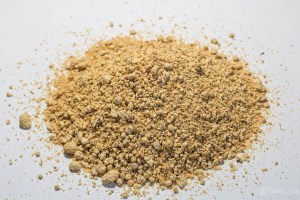
Soya meal has a much higher protein content than pulses, so it wouldn’t be possible to fully replace this with beans or peas in livestock diets.
“I think there’s a massive opportunity for domestically grown beans and peas as a substitute for soya in livestock feed,” he explains. “But such is the volume of soya that’s consumed in the UK that we couldn’t replace all of it with homegrown pulses. Soya meal also has a much higher protein content than pulses, so it wouldn’t be possible to fully replace it with beans or peas in livestock diets. However, using domestically grown pulses could make a massive dent in soya bean imports.
“And although it’s desirable to massively reduce soya use from an environmental perspective, it has to be economical as well,” says Roger. “Any alternative feeds farmers consider have to stack up financially. If they don’t, you won’t achieve a great deal. But this might be something that public money will contribute to in the future.”
Duncan Farms, a producer/packer in Aberdeenshire, is one enterprise that has turned to homegrown beans in an attempt to create a carbon neutral egg from 64,000 of its 446,000 free range hens.
Alistair McBain, rearing and production manager, started with the firm a little over a year ago and was tasked with reducing the carbon footprint of egg production. “We’re trying to achieve a net zero egg, partially because of pressure from retailers and consumers, and also because we feel there’s a commercial opportunity in doing so,” he explains. “This is going to be more costly for us, so it has to be linked to a premium egg and we have had a lot of interest from retailers about paying for this.”
Around 80% of the firm’s carbon footprint for its egg production enterprise is from feed, and 80% of that is from soya, so Alistair set about looking at alternatives. “Beans came up trumps as we can grow them ourselves.”
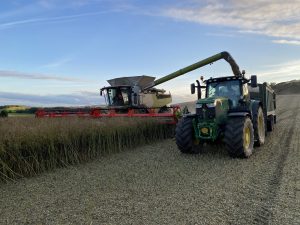
Growing beans had to fit into Duncan Farms’ existing system, with earliness being paramount.
The business has around 2630ha of arable land that produces 90% of its own cereal requirement, with soya and minerals imported before it’s milled and mixed on site. “We grow 25,000t of cereals and all of that goes back into the hens, other than some malting barley and milling oats,” says Alistair.
“We’re initially looking to reduce the soya use in the ration by 50% and replace it with rape meal and beans, based on nutritional advice from Harbro and Trouw.” Changing the ration has involved trying to make sure there are no unwanted side effects to either egg quality, feed intake or hen behaviour.
“In the long-term we want to reduce soya use by 100% but a lot of work has to be done before we can get there,” says Alistair. “We’ve gathered from others that this is very difficult to do as soya provides something that just can’t be replicated with synthetic amino acids or by beans.”
But this hasn’t deterred him or the farm’s arable manager, Sandy Norrie. “I’ve been working here 26 years, and this is new for me; I’ve never grown beans before.”
It wasn’t just a case of diving in. Sandy did a lot of research to make sure beans would fit with the existing system. One of the challenges was using a variety that would work on the farm. “It’s crucial we have a very early maturing variety here and we’ve chosen the earliest fields that are south facing. Luckily, we’ve got enough land suited to beans to keep us going throughout the rotation.”
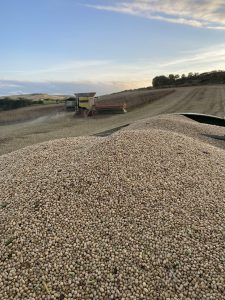
LG Raptor achieved 5.4t/ha in its first year on the farm and the beans are due to go into the hen feed from the spring of 2023.
This year (2022), Sandy grew 26ha of LG Raptor, which he found a “doddle”. “We were advised against growing winter beans because the yield benefit versus the risk from birds and the weather over winter just didn’t stack up. And as we’re predominantly winter cropping, growing spring beans helps to spread the workload.
“We ploughed as normal, no manure was applied, and we drilled at 50 seeds/m², as close to 10cm as the drill could go,” he explains. Using a Lemken power harrow drill combination in February, the beans were planted in dry conditions and came through the ground relatively quickly. Conveniently, the Lemken machine could be adjusted to plant different seed sizes, so there was no need for investment in new equipment.
“The one disappointment was that my first choice of pre-emergence herbicide was sold out, but the beans grew through the weeds in the end,” says Sandy.
“We didn’t have to apply any P or K, as we have high levels in the soil here, so in that respect it was a very cheap crop to grow. Plus, there was no sign of chocolate spot and we never had a problem with powdery mildew either.”
The crop had a trace element spray six weeks after establishment, followed by an insecticide, more trace elements, sulphur and manganese in June, says Sandy. “We applied the first fungicide at the end of June and a second in July, ahead of glyphosate in August before we harvested in September. With the weather the way it was this year, I think that if we’d left the beans for another week, we wouldn’t even have had to desiccate them.”
One of the fears when going into spring beans was that they wouldn’t be fit until really late in the season, meaning he’d not be able to drill winter wheat and would instead have to put the bean ground to spring barley. “I thought we’d be harvesting in November,” says Sandy. “But we combined them in the first week of September. If I get that every year, I’ll be very happy. But I know we had an exceptional year and I don’t expect it to always be that way.”
And he’s pleased with how the beans performed considering it was the first year growing them. “I was aiming for 4.9t/ha and we got 5.4t/ha. I do wonder if the beans would have had more potential if we’d managed to get the correct herbicide, as they may have been a bit smothered by volunteer oilseed rape.”
The beans were analysed by Harbro with germination testing at 96%, and analysis showed a 45.5% starch content, 26.8% crude protein, 14.2% neutral detergent fibre, 13% oil content, 7.3% fibre, 2.9% ash and a specific weight of 87kg/hl. “They were really heavy, we had a shock when we weighed the trailer,” says Sandy.
Next year he’s planning to grow 32ha of Raptor and is trialling 16ha of Yukon. “Yukon is a very early maturing variety and I’ve heard of farmers in Fife who have harvested it two weeks before anyone else in the area.”
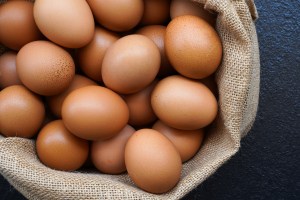
There’s pressure from both consumers and retailers to cut carbon emissions from egg production.
Looking at the financials of growing beans, Sandy isn’t sure how they stack up yet. “This year was a bit different as we have had high crop prices and I had bought my fertiliser really cheap, plus, we’re yet to see the benefits in the following crop – I think it will take two or three years before we see any.”

Beans can only be fed to hens in certain quantities to avoid behavioural and egg quality changes.
But Sandy’s also using the beans as an opportunity to do N trials in the following wheat crops. “We had beans in three fields this year, so those are now in wheat and I’m putting different rates of N on each one to see how they fare,” he explains.
And although the hens won’t be fed any beans until the coming spring, Alistair is fully committed to doing further research into replacing soya protein in egg production. “I’ve been awarded a Nuffield Scholarship to look into alternative proteins to drive net zero egg production. One area of focus is on beans and how these can be improved for poultry diets.”
He and Sandy will also look to increase the bean area on farm, but they know it’s not possible for them to grow enough to feed all of the farm’s hens. “The demand for beans in hen feed might open up a bit of a market and we would certainly look at purchasing beans from further south,” says Alistair.
Breeding for better
As interest in homegrown beans for feed has grown, breeders have turned their attention to producing varieties that are better suited to this purpose. The Abo-Vici project has specifically looked at how beans can be used in laying hen diets.
Although beans can have around 30-35% crude protein, their use in animal feed can’t necessarily be increased because their composition – predominantly the vicin and convicin content – can cause issues for hens and other monogastrics, such as pigs, explains Michael Shuldham of LSPB. This means that the maximum inclusion rate in a feed mix is normally about 10% for beans.
However, LSPB has been breeding varieties low in vicin and convicin specifically to overcome this issue. These new LVC varieties can be fed to monogastrics at higher quantities than normal beans without any adverse side effects, potentially pushing up their inclusion rate in the ration, explains Michael.
“Based on research conducted in Germany, a 15% inclusion rate of standard bean varieties in the ration caused adverse effects in laying hens, such as lower feed intake and reduced egg quality. But with LVC varieties the inclusion rate could be increased to 30% without any issues.
“This means there’s an exciting opportunity to increase the amount of beans grown in the UK for monogastric consumption, which would reduce reliance on imported soya. Plus, growers can still benefit from all of the other elements beans bring, including increased biodiversity, better soil health and providing a flowering crop for bees.”
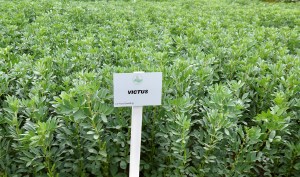
Victus is an LVC variety from LSPB which can be fed to chickens and pigs in higher quantities than regular bean varieties.
The headline LVC variety from LSPB was Tiffany, which has been followed by its latest addition, Victus – both spring beans, says Michael. “We have another in the pipeline that should challenge the top varieties for yield and growers can hear more about this one in the spring.”
Tiffany came to the UK market in 2019 after at least 10 years’ worth of research and breeding beforehand, says Michael. “Our breeding programme is looking at LVC varieties as part of the future of growing beans. And these varieties have the same market outlets as standard varieties, so they can also go for human consumption.”
Eagle-eyed readers who have seen the recently released PGRO 2022 Descriptive List (see article on pxx) will have noticed that the previous ‘pale hilum and LVC’ specific row has been removed from the table. Instead, these varieties are now part of the main list where they can be more easily compared with the rest. “This move is a big step and I hope it will help people see the real benefits of these varieties,” adds Michael.
This article was taken from the latest issue of CPM. For more articles like this, subscribe here.

